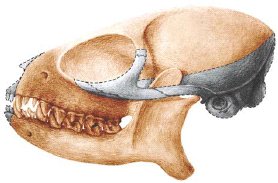Teeny Skull Reveals Ancient Ancestor
A tiny fossil skull represents the earliest known ancestor of monkeys and apes.
By Emily Sohn
How did people get here? Some paleontologists are fascinated with tracing our ancestors back to the earliest possible times. A fossil skull in China is the latest clue to the origin of the human species.
The fossil comes from the oldest known primate, a tiny animal that lived in south-central China 55 million years ago. The animal belongs to a group called Teilhardina. Until now, Teilhardina remains had been found only in North America and Europe. Its descendants include today’s tarsiers, monkeys, and apes.
 |
|
The skull of the newly found ancestor of monkeys is about 55 million years old and only about 1 inch wide. In this diagram of the skull, the gray areas indicate parts missing from the original fossil. |
| Nature |
The newly discovered creature was smaller than any primate alive today. It weighed just 1 ounce and would have fit in the palm of your hand. Because it was so small and had such sharp teeth, researchers from the Chinese Academy of Sciences in Beijing think that it ate insects.
The animal also had small eyes that faced forward, meaning that it might have been active during the day and slept at night. That’s surprising because many of Teilhardina‘s modern relatives eat at night. Other researchers argue that the ancient primate was indeed nocturnal. They base their conclusion on evidence that it had whiskers like most modern nocturnal animals.
Scientists are now debating whether primates originated in Asia—rather than in Africa—before migrating around the world.
As discussions continue, you might just find it interesting to consider that one of your earliest ancestors could have easily fit in your shoe!—E. Sohn
Going Deeper:
Bower, Bruce. 2004. Ancestral handful: Tiny skull puts Asia at root of primate tree. Science News 165(Jan. 3):4-5. Available at http://www.sciencenews.org/20040103/fob4.asp .
You can learn more about early primates at anthro.palomar.edu/earlyprimates/first_primates.htm (Palomar College).







